Report: Embedding a Culture of Evidence-Based Practice in Healthcare
VerifiedAdded on 2023/02/01
|9
|2155
|86
Report
AI Summary
This report provides a detailed analysis of embedding a culture of evidence-based practice (EBP) within a healthcare institution. It addresses the current utilization of EBP, strategies for encouraging nurses to implement EBP ideas, and the essential factors for successful implementation, such as shared governance, educational programs, and leadership support. The report also identifies necessary changes in the workplace to improve EBP, including addressing time constraints, organizational culture, and the role of managers and mentors. The author emphasizes the importance of providing adequate resources and support for nurses to effectively integrate evidence into their clinical practice, ultimately aiming to improve patient outcomes and the overall quality of care. The report concludes by highlighting the importance of addressing identified challenges and promoting a supportive environment for EBP adoption.
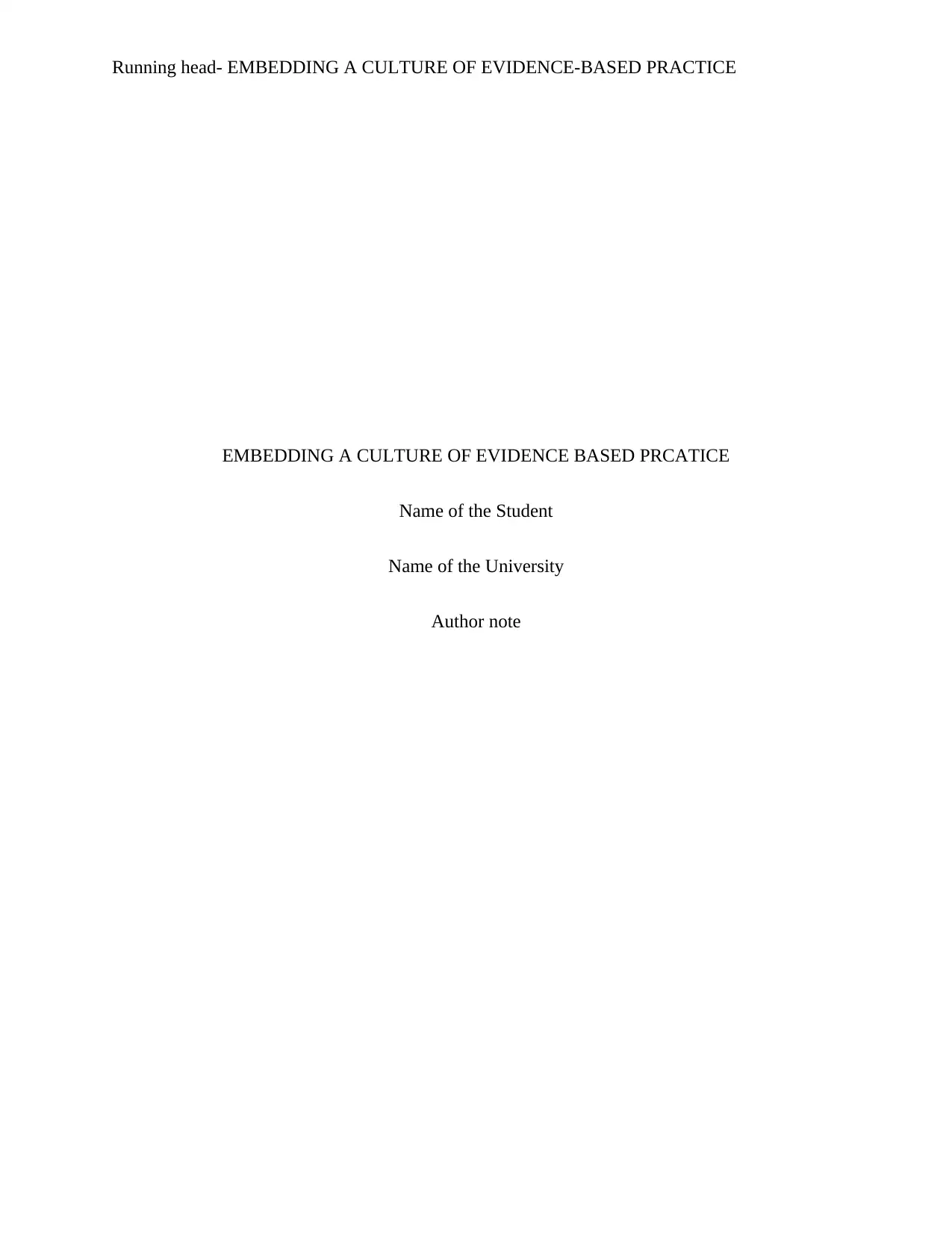
Running head- EMBEDDING A CULTURE OF EVIDENCE-BASED PRACTICE
EMBEDDING A CULTURE OF EVIDENCE BASED PRCATICE
Name of the Student
Name of the University
Author note
EMBEDDING A CULTURE OF EVIDENCE BASED PRCATICE
Name of the Student
Name of the University
Author note
Paraphrase This Document
Need a fresh take? Get an instant paraphrase of this document with our AI Paraphraser
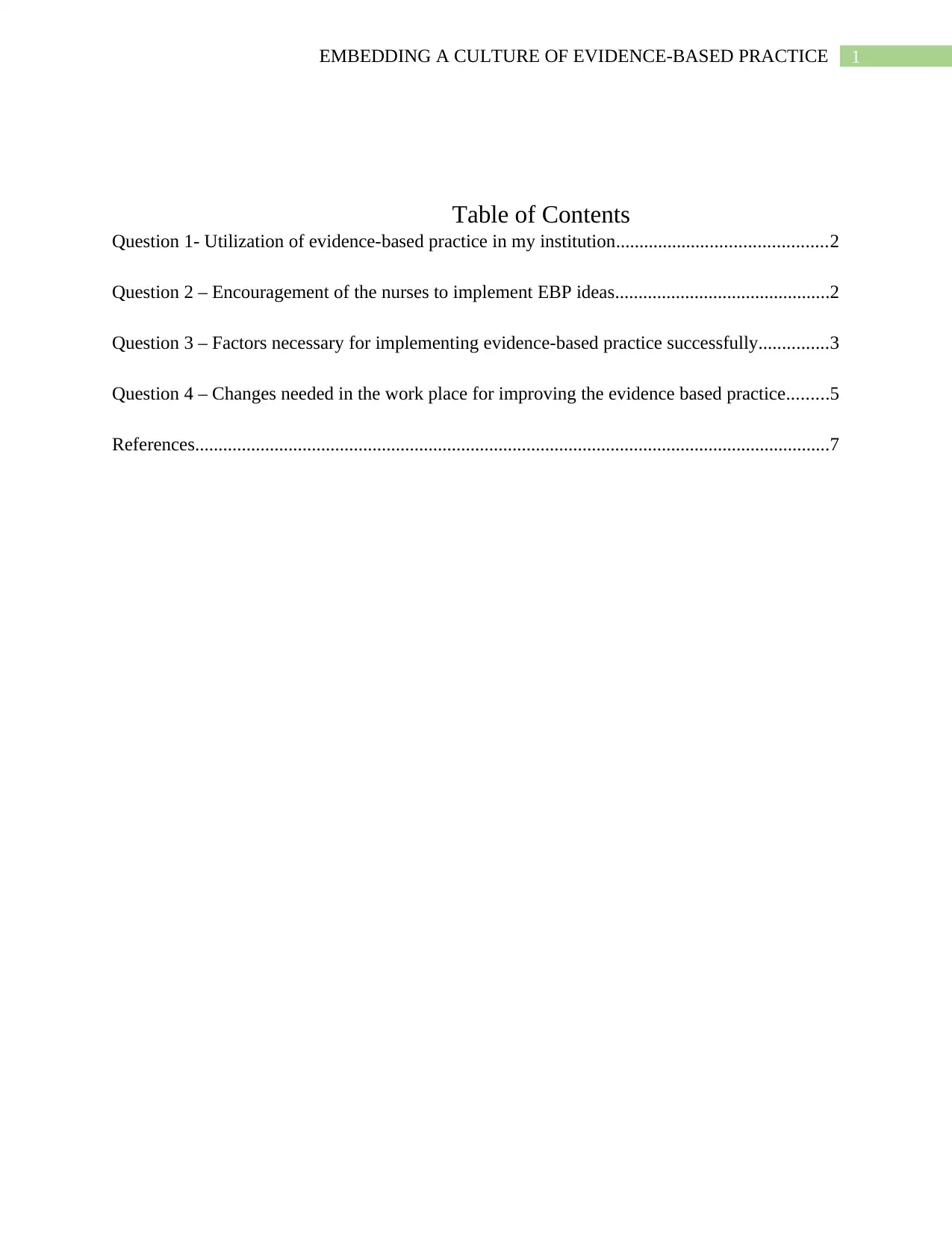
1EMBEDDING A CULTURE OF EVIDENCE-BASED PRACTICE
Table of Contents
Question 1- Utilization of evidence-based practice in my institution.............................................2
Question 2 – Encouragement of the nurses to implement EBP ideas..............................................2
Question 3 – Factors necessary for implementing evidence-based practice successfully...............3
Question 4 – Changes needed in the work place for improving the evidence based practice.........5
References........................................................................................................................................7
Table of Contents
Question 1- Utilization of evidence-based practice in my institution.............................................2
Question 2 – Encouragement of the nurses to implement EBP ideas..............................................2
Question 3 – Factors necessary for implementing evidence-based practice successfully...............3
Question 4 – Changes needed in the work place for improving the evidence based practice.........5
References........................................................................................................................................7
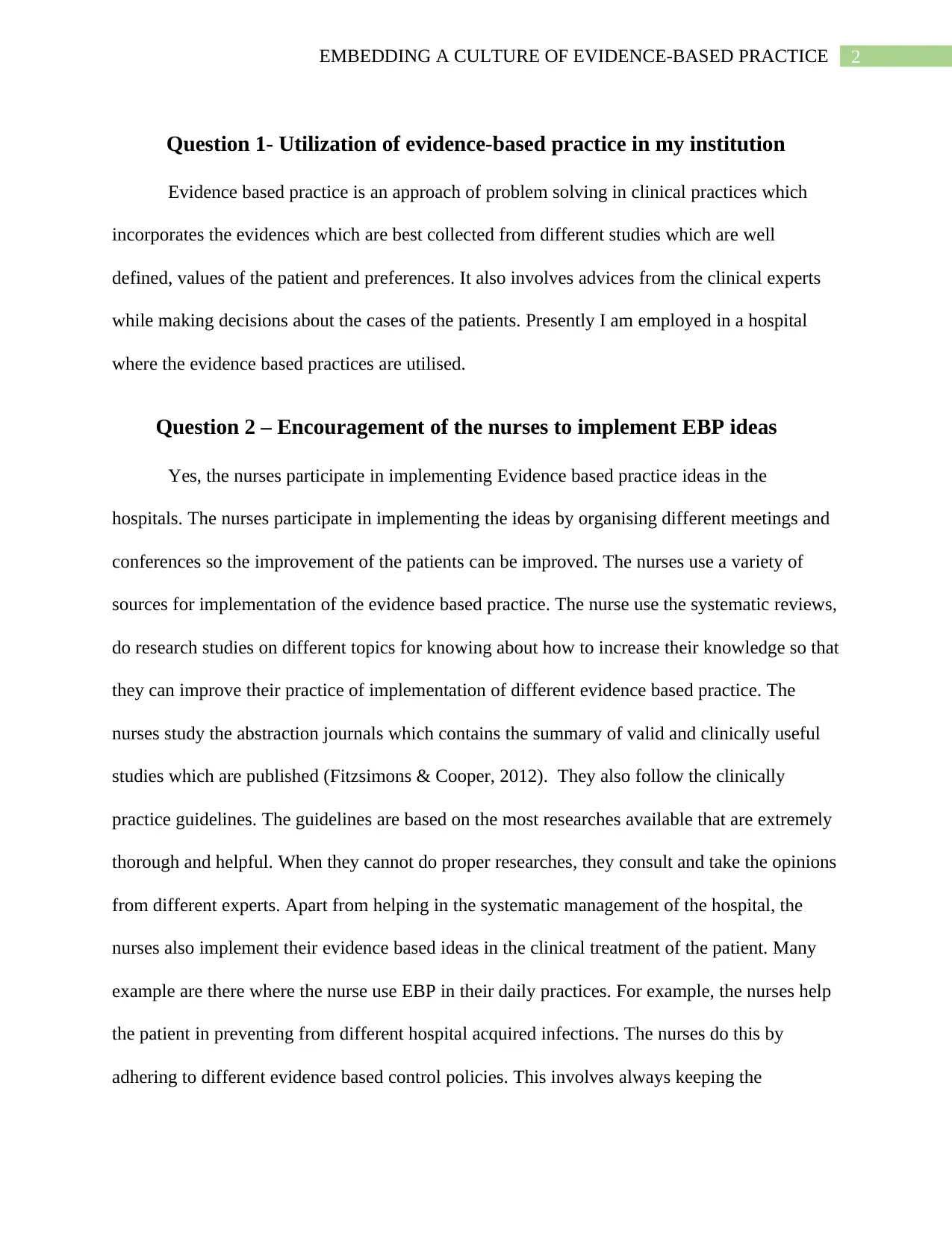
2EMBEDDING A CULTURE OF EVIDENCE-BASED PRACTICE
Question 1- Utilization of evidence-based practice in my institution
Evidence based practice is an approach of problem solving in clinical practices which
incorporates the evidences which are best collected from different studies which are well
defined, values of the patient and preferences. It also involves advices from the clinical experts
while making decisions about the cases of the patients. Presently I am employed in a hospital
where the evidence based practices are utilised.
Question 2 – Encouragement of the nurses to implement EBP ideas
Yes, the nurses participate in implementing Evidence based practice ideas in the
hospitals. The nurses participate in implementing the ideas by organising different meetings and
conferences so the improvement of the patients can be improved. The nurses use a variety of
sources for implementation of the evidence based practice. The nurse use the systematic reviews,
do research studies on different topics for knowing about how to increase their knowledge so that
they can improve their practice of implementation of different evidence based practice. The
nurses study the abstraction journals which contains the summary of valid and clinically useful
studies which are published (Fitzsimons & Cooper, 2012). They also follow the clinically
practice guidelines. The guidelines are based on the most researches available that are extremely
thorough and helpful. When they cannot do proper researches, they consult and take the opinions
from different experts. Apart from helping in the systematic management of the hospital, the
nurses also implement their evidence based ideas in the clinical treatment of the patient. Many
example are there where the nurse use EBP in their daily practices. For example, the nurses help
the patient in preventing from different hospital acquired infections. The nurses do this by
adhering to different evidence based control policies. This involves always keeping the
Question 1- Utilization of evidence-based practice in my institution
Evidence based practice is an approach of problem solving in clinical practices which
incorporates the evidences which are best collected from different studies which are well
defined, values of the patient and preferences. It also involves advices from the clinical experts
while making decisions about the cases of the patients. Presently I am employed in a hospital
where the evidence based practices are utilised.
Question 2 – Encouragement of the nurses to implement EBP ideas
Yes, the nurses participate in implementing Evidence based practice ideas in the
hospitals. The nurses participate in implementing the ideas by organising different meetings and
conferences so the improvement of the patients can be improved. The nurses use a variety of
sources for implementation of the evidence based practice. The nurse use the systematic reviews,
do research studies on different topics for knowing about how to increase their knowledge so that
they can improve their practice of implementation of different evidence based practice. The
nurses study the abstraction journals which contains the summary of valid and clinically useful
studies which are published (Fitzsimons & Cooper, 2012). They also follow the clinically
practice guidelines. The guidelines are based on the most researches available that are extremely
thorough and helpful. When they cannot do proper researches, they consult and take the opinions
from different experts. Apart from helping in the systematic management of the hospital, the
nurses also implement their evidence based ideas in the clinical treatment of the patient. Many
example are there where the nurse use EBP in their daily practices. For example, the nurses help
the patient in preventing from different hospital acquired infections. The nurses do this by
adhering to different evidence based control policies. This involves always keeping the
⊘ This is a preview!⊘
Do you want full access?
Subscribe today to unlock all pages.

Trusted by 1+ million students worldwide
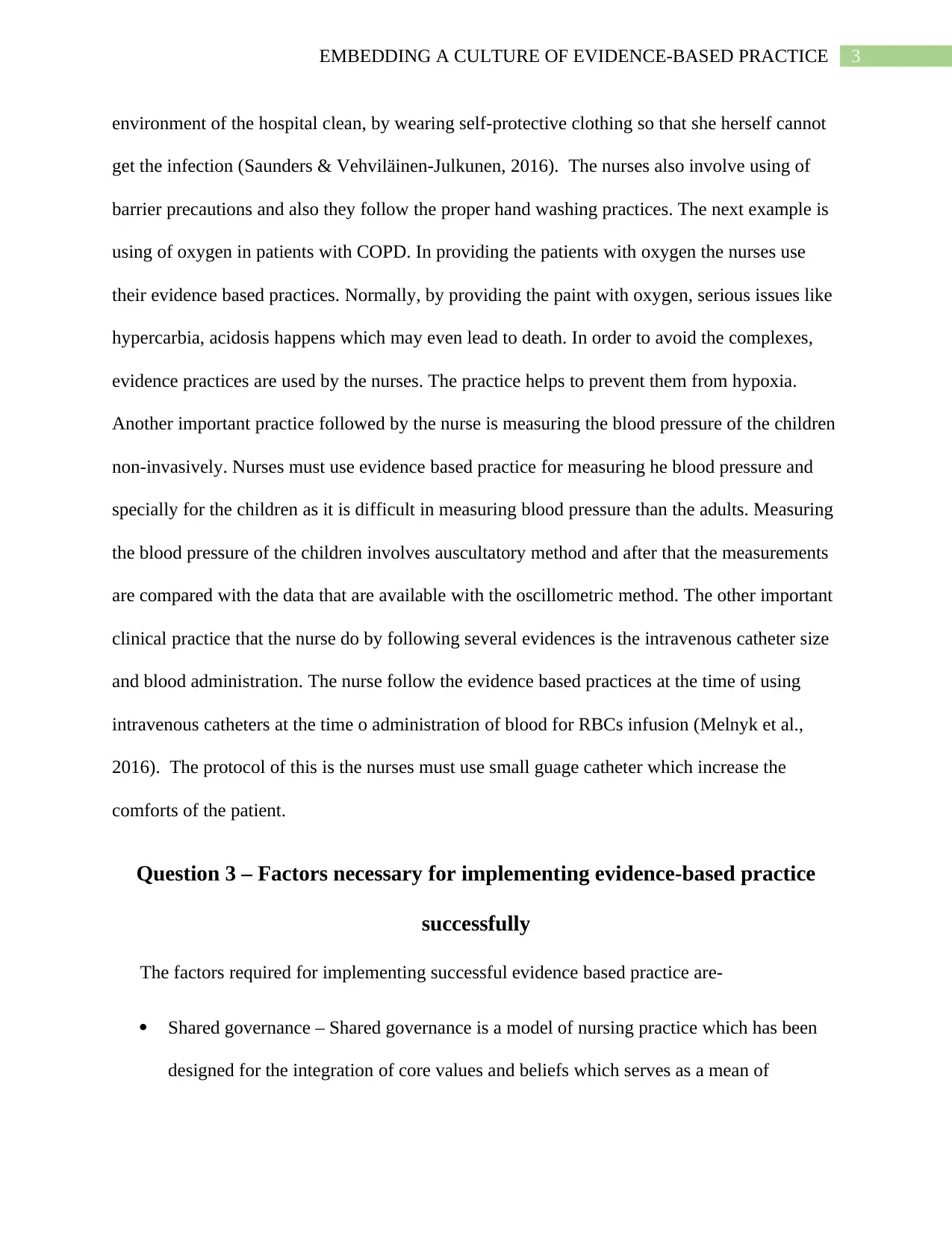
3EMBEDDING A CULTURE OF EVIDENCE-BASED PRACTICE
environment of the hospital clean, by wearing self-protective clothing so that she herself cannot
get the infection (Saunders & Vehviläinen-Julkunen, 2016). The nurses also involve using of
barrier precautions and also they follow the proper hand washing practices. The next example is
using of oxygen in patients with COPD. In providing the patients with oxygen the nurses use
their evidence based practices. Normally, by providing the paint with oxygen, serious issues like
hypercarbia, acidosis happens which may even lead to death. In order to avoid the complexes,
evidence practices are used by the nurses. The practice helps to prevent them from hypoxia.
Another important practice followed by the nurse is measuring the blood pressure of the children
non-invasively. Nurses must use evidence based practice for measuring he blood pressure and
specially for the children as it is difficult in measuring blood pressure than the adults. Measuring
the blood pressure of the children involves auscultatory method and after that the measurements
are compared with the data that are available with the oscillometric method. The other important
clinical practice that the nurse do by following several evidences is the intravenous catheter size
and blood administration. The nurse follow the evidence based practices at the time of using
intravenous catheters at the time o administration of blood for RBCs infusion (Melnyk et al.,
2016). The protocol of this is the nurses must use small guage catheter which increase the
comforts of the patient.
Question 3 – Factors necessary for implementing evidence-based practice
successfully
The factors required for implementing successful evidence based practice are-
Shared governance – Shared governance is a model of nursing practice which has been
designed for the integration of core values and beliefs which serves as a mean of
environment of the hospital clean, by wearing self-protective clothing so that she herself cannot
get the infection (Saunders & Vehviläinen-Julkunen, 2016). The nurses also involve using of
barrier precautions and also they follow the proper hand washing practices. The next example is
using of oxygen in patients with COPD. In providing the patients with oxygen the nurses use
their evidence based practices. Normally, by providing the paint with oxygen, serious issues like
hypercarbia, acidosis happens which may even lead to death. In order to avoid the complexes,
evidence practices are used by the nurses. The practice helps to prevent them from hypoxia.
Another important practice followed by the nurse is measuring the blood pressure of the children
non-invasively. Nurses must use evidence based practice for measuring he blood pressure and
specially for the children as it is difficult in measuring blood pressure than the adults. Measuring
the blood pressure of the children involves auscultatory method and after that the measurements
are compared with the data that are available with the oscillometric method. The other important
clinical practice that the nurse do by following several evidences is the intravenous catheter size
and blood administration. The nurse follow the evidence based practices at the time of using
intravenous catheters at the time o administration of blood for RBCs infusion (Melnyk et al.,
2016). The protocol of this is the nurses must use small guage catheter which increase the
comforts of the patient.
Question 3 – Factors necessary for implementing evidence-based practice
successfully
The factors required for implementing successful evidence based practice are-
Shared governance – Shared governance is a model of nursing practice which has been
designed for the integration of core values and beliefs which serves as a mean of
Paraphrase This Document
Need a fresh take? Get an instant paraphrase of this document with our AI Paraphraser
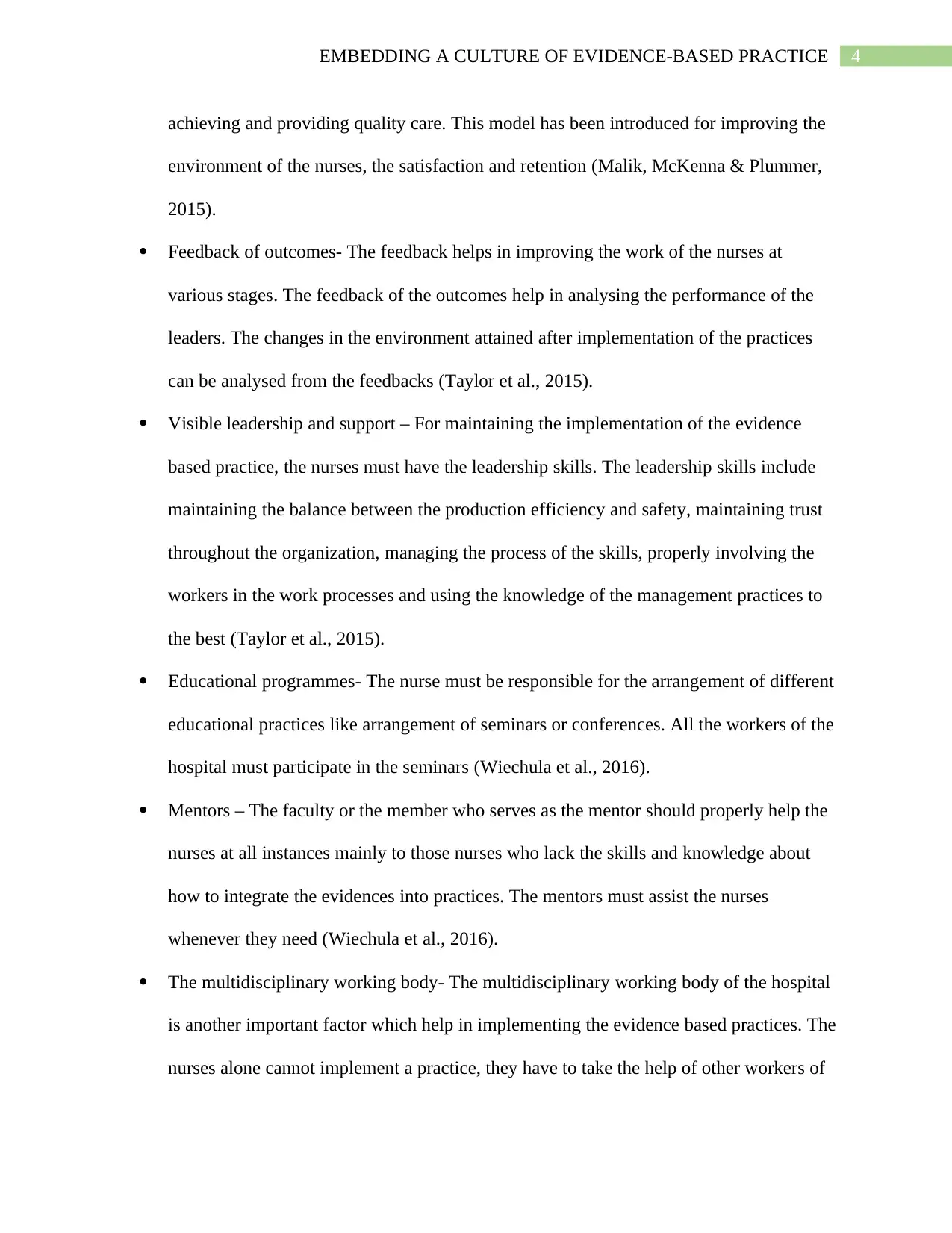
4EMBEDDING A CULTURE OF EVIDENCE-BASED PRACTICE
achieving and providing quality care. This model has been introduced for improving the
environment of the nurses, the satisfaction and retention (Malik, McKenna & Plummer,
2015).
Feedback of outcomes- The feedback helps in improving the work of the nurses at
various stages. The feedback of the outcomes help in analysing the performance of the
leaders. The changes in the environment attained after implementation of the practices
can be analysed from the feedbacks (Taylor et al., 2015).
Visible leadership and support – For maintaining the implementation of the evidence
based practice, the nurses must have the leadership skills. The leadership skills include
maintaining the balance between the production efficiency and safety, maintaining trust
throughout the organization, managing the process of the skills, properly involving the
workers in the work processes and using the knowledge of the management practices to
the best (Taylor et al., 2015).
Educational programmes- The nurse must be responsible for the arrangement of different
educational practices like arrangement of seminars or conferences. All the workers of the
hospital must participate in the seminars (Wiechula et al., 2016).
Mentors – The faculty or the member who serves as the mentor should properly help the
nurses at all instances mainly to those nurses who lack the skills and knowledge about
how to integrate the evidences into practices. The mentors must assist the nurses
whenever they need (Wiechula et al., 2016).
The multidisciplinary working body- The multidisciplinary working body of the hospital
is another important factor which help in implementing the evidence based practices. The
nurses alone cannot implement a practice, they have to take the help of other workers of
achieving and providing quality care. This model has been introduced for improving the
environment of the nurses, the satisfaction and retention (Malik, McKenna & Plummer,
2015).
Feedback of outcomes- The feedback helps in improving the work of the nurses at
various stages. The feedback of the outcomes help in analysing the performance of the
leaders. The changes in the environment attained after implementation of the practices
can be analysed from the feedbacks (Taylor et al., 2015).
Visible leadership and support – For maintaining the implementation of the evidence
based practice, the nurses must have the leadership skills. The leadership skills include
maintaining the balance between the production efficiency and safety, maintaining trust
throughout the organization, managing the process of the skills, properly involving the
workers in the work processes and using the knowledge of the management practices to
the best (Taylor et al., 2015).
Educational programmes- The nurse must be responsible for the arrangement of different
educational practices like arrangement of seminars or conferences. All the workers of the
hospital must participate in the seminars (Wiechula et al., 2016).
Mentors – The faculty or the member who serves as the mentor should properly help the
nurses at all instances mainly to those nurses who lack the skills and knowledge about
how to integrate the evidences into practices. The mentors must assist the nurses
whenever they need (Wiechula et al., 2016).
The multidisciplinary working body- The multidisciplinary working body of the hospital
is another important factor which help in implementing the evidence based practices. The
nurses alone cannot implement a practice, they have to take the help of other workers of
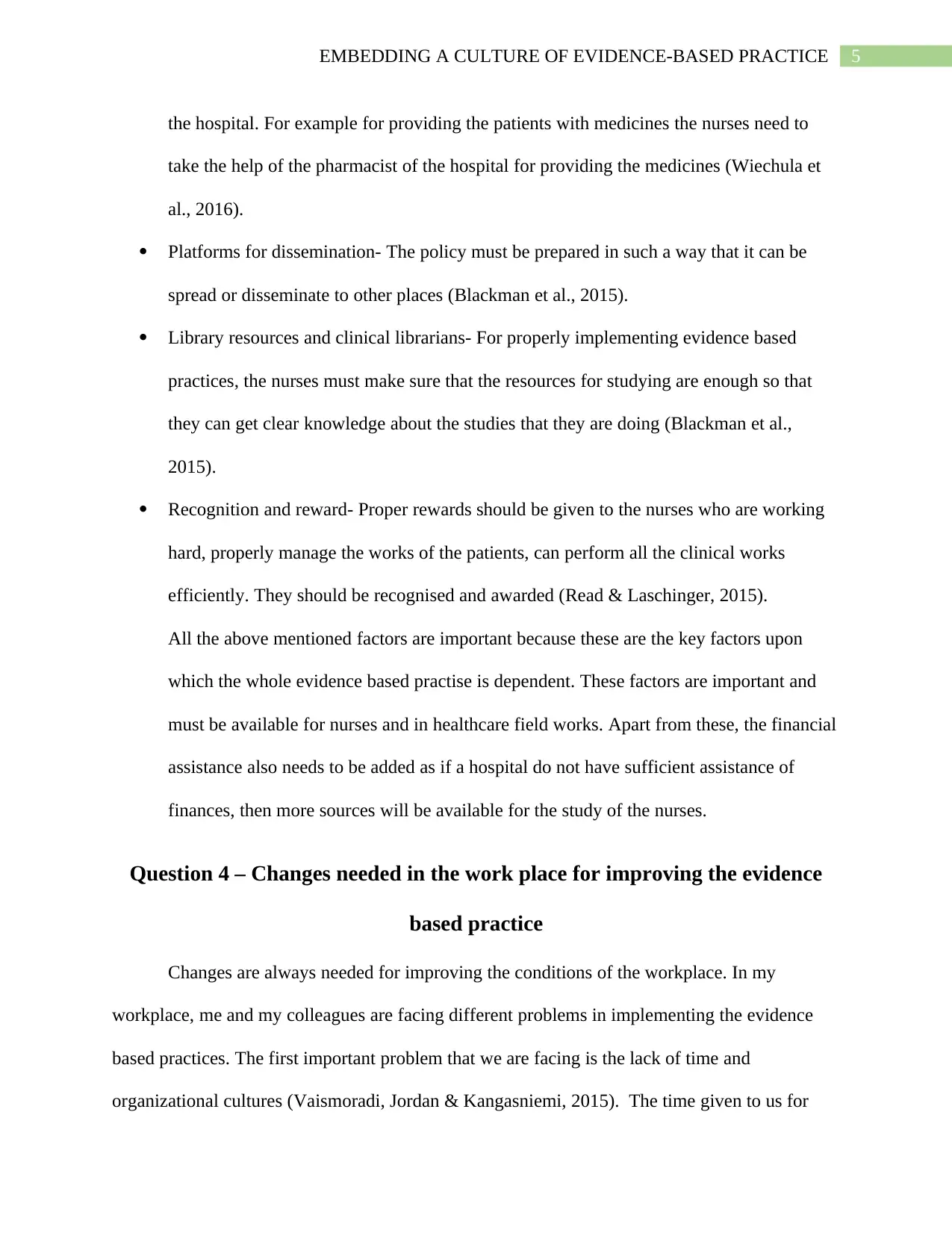
5EMBEDDING A CULTURE OF EVIDENCE-BASED PRACTICE
the hospital. For example for providing the patients with medicines the nurses need to
take the help of the pharmacist of the hospital for providing the medicines (Wiechula et
al., 2016).
Platforms for dissemination- The policy must be prepared in such a way that it can be
spread or disseminate to other places (Blackman et al., 2015).
Library resources and clinical librarians- For properly implementing evidence based
practices, the nurses must make sure that the resources for studying are enough so that
they can get clear knowledge about the studies that they are doing (Blackman et al.,
2015).
Recognition and reward- Proper rewards should be given to the nurses who are working
hard, properly manage the works of the patients, can perform all the clinical works
efficiently. They should be recognised and awarded (Read & Laschinger, 2015).
All the above mentioned factors are important because these are the key factors upon
which the whole evidence based practise is dependent. These factors are important and
must be available for nurses and in healthcare field works. Apart from these, the financial
assistance also needs to be added as if a hospital do not have sufficient assistance of
finances, then more sources will be available for the study of the nurses.
Question 4 – Changes needed in the work place for improving the evidence
based practice
Changes are always needed for improving the conditions of the workplace. In my
workplace, me and my colleagues are facing different problems in implementing the evidence
based practices. The first important problem that we are facing is the lack of time and
organizational cultures (Vaismoradi, Jordan & Kangasniemi, 2015). The time given to us for
the hospital. For example for providing the patients with medicines the nurses need to
take the help of the pharmacist of the hospital for providing the medicines (Wiechula et
al., 2016).
Platforms for dissemination- The policy must be prepared in such a way that it can be
spread or disseminate to other places (Blackman et al., 2015).
Library resources and clinical librarians- For properly implementing evidence based
practices, the nurses must make sure that the resources for studying are enough so that
they can get clear knowledge about the studies that they are doing (Blackman et al.,
2015).
Recognition and reward- Proper rewards should be given to the nurses who are working
hard, properly manage the works of the patients, can perform all the clinical works
efficiently. They should be recognised and awarded (Read & Laschinger, 2015).
All the above mentioned factors are important because these are the key factors upon
which the whole evidence based practise is dependent. These factors are important and
must be available for nurses and in healthcare field works. Apart from these, the financial
assistance also needs to be added as if a hospital do not have sufficient assistance of
finances, then more sources will be available for the study of the nurses.
Question 4 – Changes needed in the work place for improving the evidence
based practice
Changes are always needed for improving the conditions of the workplace. In my
workplace, me and my colleagues are facing different problems in implementing the evidence
based practices. The first important problem that we are facing is the lack of time and
organizational cultures (Vaismoradi, Jordan & Kangasniemi, 2015). The time given to us for
⊘ This is a preview!⊘
Do you want full access?
Subscribe today to unlock all pages.

Trusted by 1+ million students worldwide
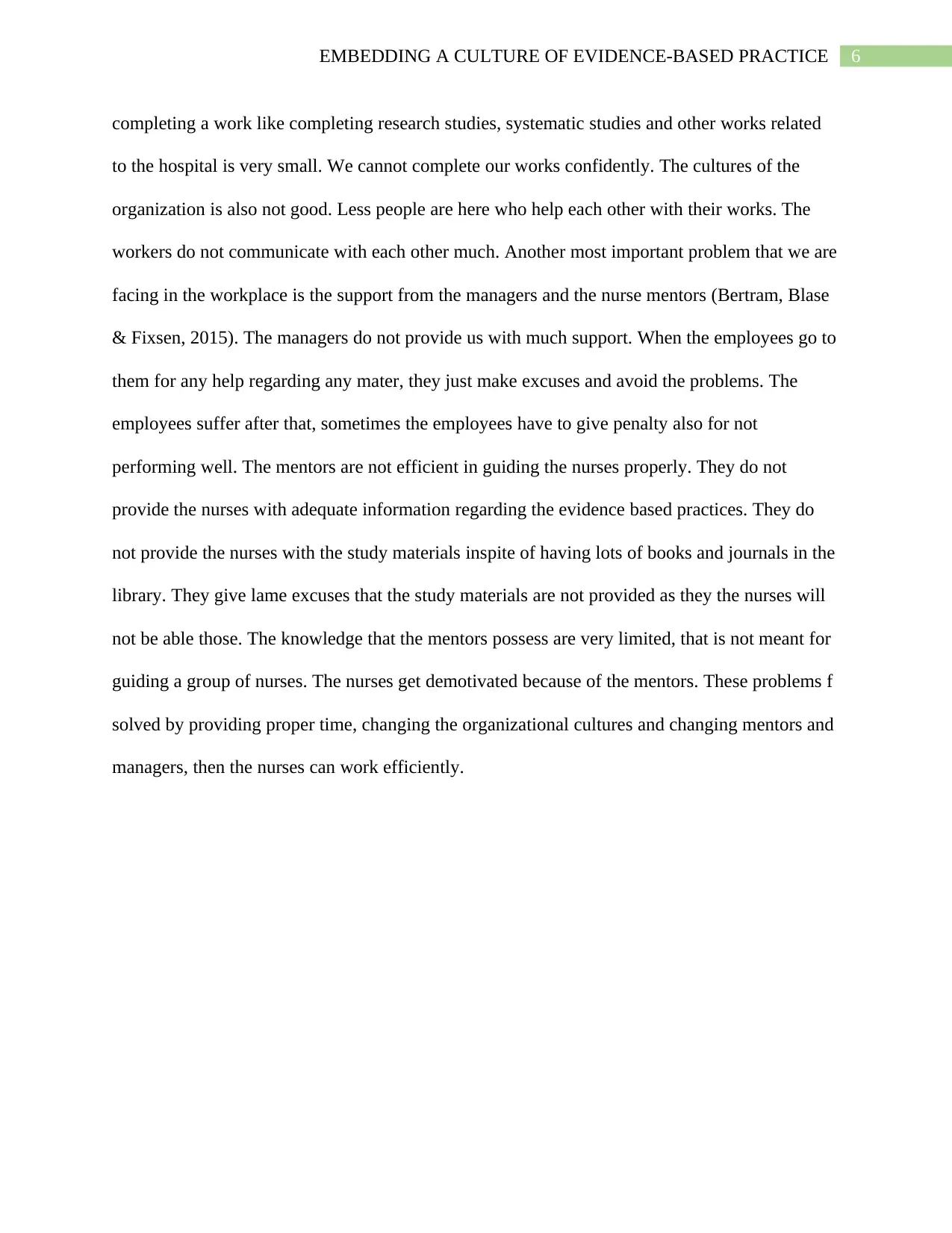
6EMBEDDING A CULTURE OF EVIDENCE-BASED PRACTICE
completing a work like completing research studies, systematic studies and other works related
to the hospital is very small. We cannot complete our works confidently. The cultures of the
organization is also not good. Less people are here who help each other with their works. The
workers do not communicate with each other much. Another most important problem that we are
facing in the workplace is the support from the managers and the nurse mentors (Bertram, Blase
& Fixsen, 2015). The managers do not provide us with much support. When the employees go to
them for any help regarding any mater, they just make excuses and avoid the problems. The
employees suffer after that, sometimes the employees have to give penalty also for not
performing well. The mentors are not efficient in guiding the nurses properly. They do not
provide the nurses with adequate information regarding the evidence based practices. They do
not provide the nurses with the study materials inspite of having lots of books and journals in the
library. They give lame excuses that the study materials are not provided as they the nurses will
not be able those. The knowledge that the mentors possess are very limited, that is not meant for
guiding a group of nurses. The nurses get demotivated because of the mentors. These problems f
solved by providing proper time, changing the organizational cultures and changing mentors and
managers, then the nurses can work efficiently.
completing a work like completing research studies, systematic studies and other works related
to the hospital is very small. We cannot complete our works confidently. The cultures of the
organization is also not good. Less people are here who help each other with their works. The
workers do not communicate with each other much. Another most important problem that we are
facing in the workplace is the support from the managers and the nurse mentors (Bertram, Blase
& Fixsen, 2015). The managers do not provide us with much support. When the employees go to
them for any help regarding any mater, they just make excuses and avoid the problems. The
employees suffer after that, sometimes the employees have to give penalty also for not
performing well. The mentors are not efficient in guiding the nurses properly. They do not
provide the nurses with adequate information regarding the evidence based practices. They do
not provide the nurses with the study materials inspite of having lots of books and journals in the
library. They give lame excuses that the study materials are not provided as they the nurses will
not be able those. The knowledge that the mentors possess are very limited, that is not meant for
guiding a group of nurses. The nurses get demotivated because of the mentors. These problems f
solved by providing proper time, changing the organizational cultures and changing mentors and
managers, then the nurses can work efficiently.
Paraphrase This Document
Need a fresh take? Get an instant paraphrase of this document with our AI Paraphraser
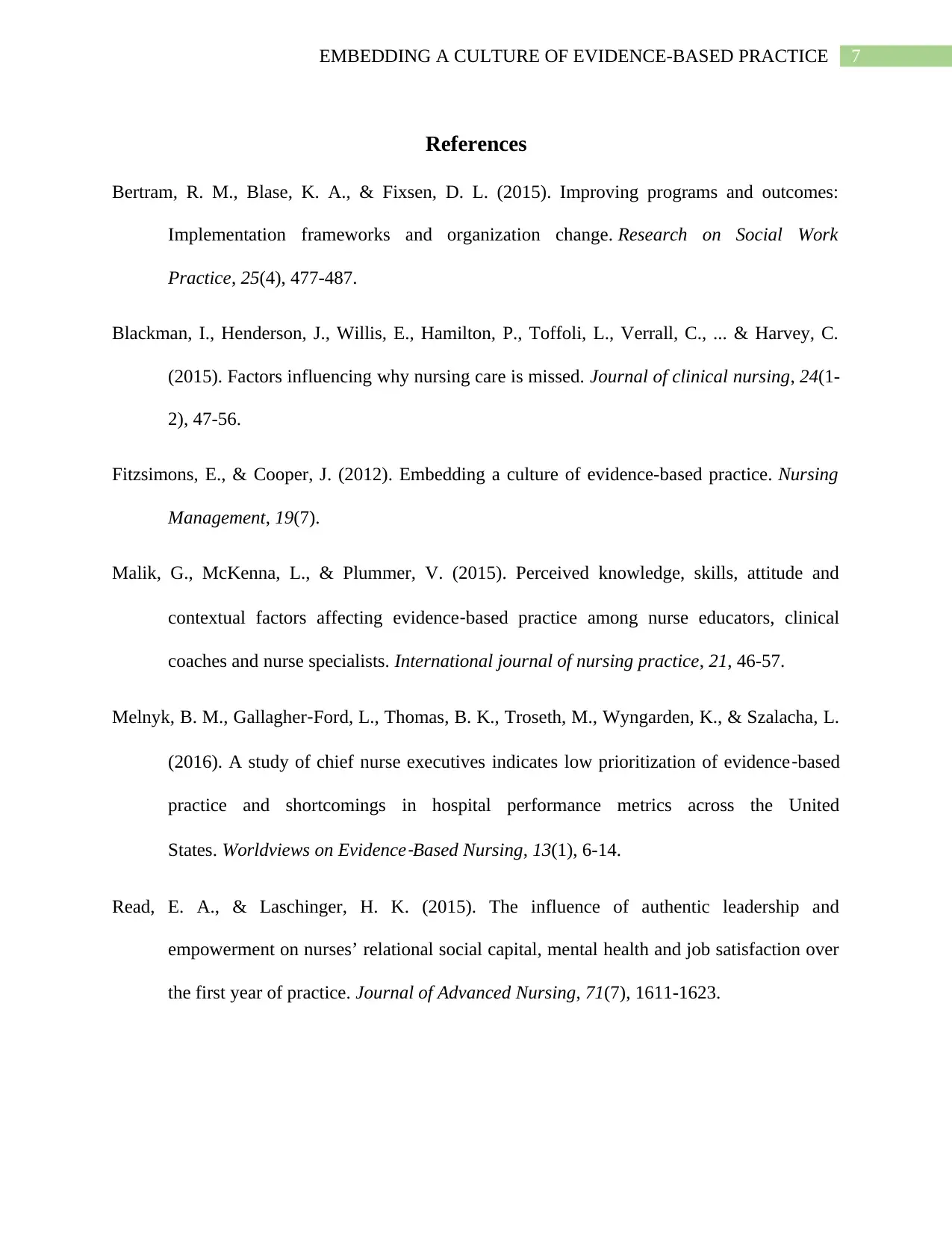
7EMBEDDING A CULTURE OF EVIDENCE-BASED PRACTICE
References
Bertram, R. M., Blase, K. A., & Fixsen, D. L. (2015). Improving programs and outcomes:
Implementation frameworks and organization change. Research on Social Work
Practice, 25(4), 477-487.
Blackman, I., Henderson, J., Willis, E., Hamilton, P., Toffoli, L., Verrall, C., ... & Harvey, C.
(2015). Factors influencing why nursing care is missed. Journal of clinical nursing, 24(1-
2), 47-56.
Fitzsimons, E., & Cooper, J. (2012). Embedding a culture of evidence-based practice. Nursing
Management, 19(7).
Malik, G., McKenna, L., & Plummer, V. (2015). Perceived knowledge, skills, attitude and
contextual factors affecting evidence‐based practice among nurse educators, clinical
coaches and nurse specialists. International journal of nursing practice, 21, 46-57.
Melnyk, B. M., Gallagher‐Ford, L., Thomas, B. K., Troseth, M., Wyngarden, K., & Szalacha, L.
(2016). A study of chief nurse executives indicates low prioritization of evidence‐based
practice and shortcomings in hospital performance metrics across the United
States. Worldviews on Evidence
‐Based Nursing, 13(1), 6-14.
Read, E. A., & Laschinger, H. K. (2015). The influence of authentic leadership and
empowerment on nurses’ relational social capital, mental health and job satisfaction over
the first year of practice. Journal of Advanced Nursing, 71(7), 1611-1623.
References
Bertram, R. M., Blase, K. A., & Fixsen, D. L. (2015). Improving programs and outcomes:
Implementation frameworks and organization change. Research on Social Work
Practice, 25(4), 477-487.
Blackman, I., Henderson, J., Willis, E., Hamilton, P., Toffoli, L., Verrall, C., ... & Harvey, C.
(2015). Factors influencing why nursing care is missed. Journal of clinical nursing, 24(1-
2), 47-56.
Fitzsimons, E., & Cooper, J. (2012). Embedding a culture of evidence-based practice. Nursing
Management, 19(7).
Malik, G., McKenna, L., & Plummer, V. (2015). Perceived knowledge, skills, attitude and
contextual factors affecting evidence‐based practice among nurse educators, clinical
coaches and nurse specialists. International journal of nursing practice, 21, 46-57.
Melnyk, B. M., Gallagher‐Ford, L., Thomas, B. K., Troseth, M., Wyngarden, K., & Szalacha, L.
(2016). A study of chief nurse executives indicates low prioritization of evidence‐based
practice and shortcomings in hospital performance metrics across the United
States. Worldviews on Evidence
‐Based Nursing, 13(1), 6-14.
Read, E. A., & Laschinger, H. K. (2015). The influence of authentic leadership and
empowerment on nurses’ relational social capital, mental health and job satisfaction over
the first year of practice. Journal of Advanced Nursing, 71(7), 1611-1623.
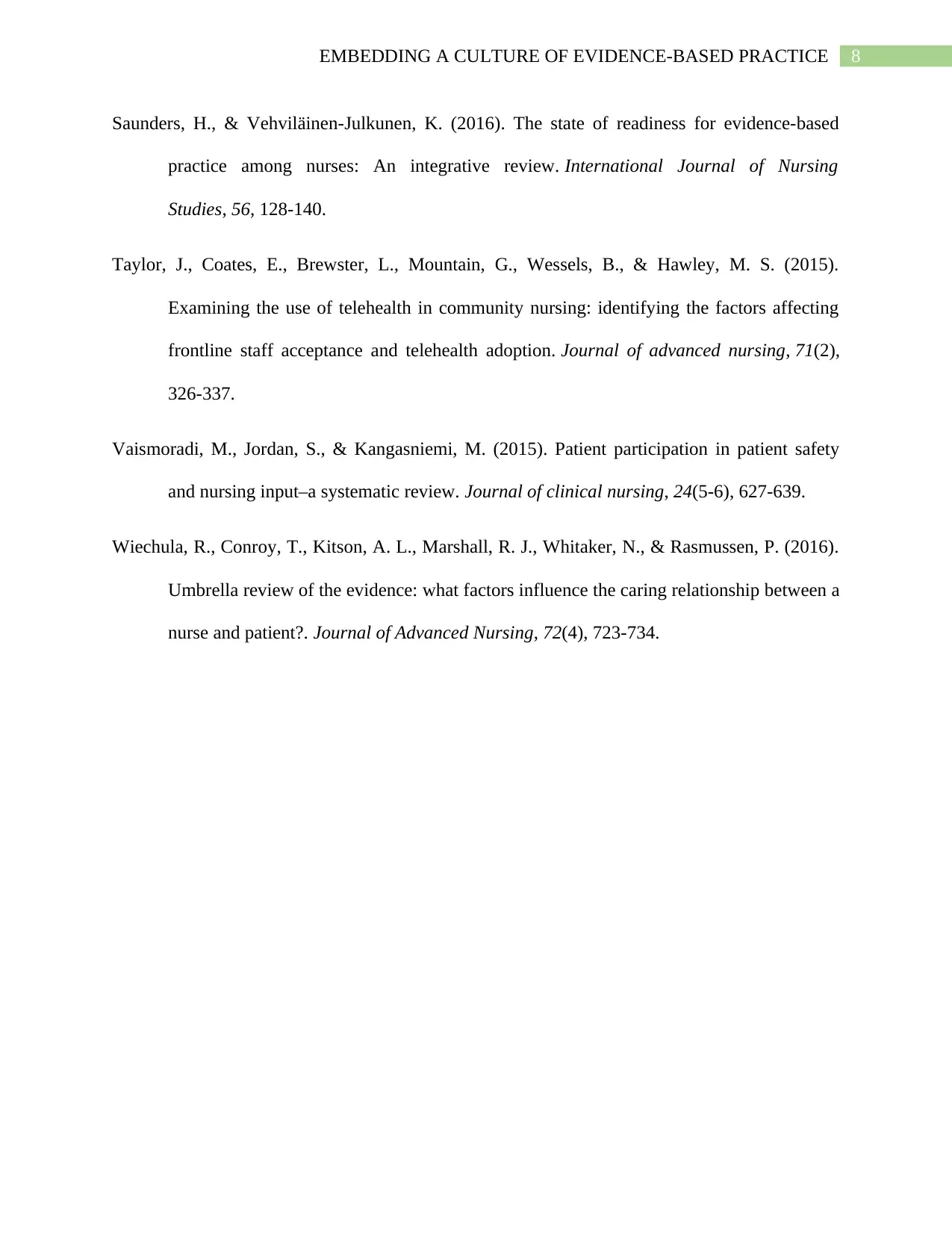
8EMBEDDING A CULTURE OF EVIDENCE-BASED PRACTICE
Saunders, H., & Vehviläinen-Julkunen, K. (2016). The state of readiness for evidence-based
practice among nurses: An integrative review. International Journal of Nursing
Studies, 56, 128-140.
Taylor, J., Coates, E., Brewster, L., Mountain, G., Wessels, B., & Hawley, M. S. (2015).
Examining the use of telehealth in community nursing: identifying the factors affecting
frontline staff acceptance and telehealth adoption. Journal of advanced nursing, 71(2),
326-337.
Vaismoradi, M., Jordan, S., & Kangasniemi, M. (2015). Patient participation in patient safety
and nursing input–a systematic review. Journal of clinical nursing, 24(5-6), 627-639.
Wiechula, R., Conroy, T., Kitson, A. L., Marshall, R. J., Whitaker, N., & Rasmussen, P. (2016).
Umbrella review of the evidence: what factors influence the caring relationship between a
nurse and patient?. Journal of Advanced Nursing, 72(4), 723-734.
Saunders, H., & Vehviläinen-Julkunen, K. (2016). The state of readiness for evidence-based
practice among nurses: An integrative review. International Journal of Nursing
Studies, 56, 128-140.
Taylor, J., Coates, E., Brewster, L., Mountain, G., Wessels, B., & Hawley, M. S. (2015).
Examining the use of telehealth in community nursing: identifying the factors affecting
frontline staff acceptance and telehealth adoption. Journal of advanced nursing, 71(2),
326-337.
Vaismoradi, M., Jordan, S., & Kangasniemi, M. (2015). Patient participation in patient safety
and nursing input–a systematic review. Journal of clinical nursing, 24(5-6), 627-639.
Wiechula, R., Conroy, T., Kitson, A. L., Marshall, R. J., Whitaker, N., & Rasmussen, P. (2016).
Umbrella review of the evidence: what factors influence the caring relationship between a
nurse and patient?. Journal of Advanced Nursing, 72(4), 723-734.
⊘ This is a preview!⊘
Do you want full access?
Subscribe today to unlock all pages.

Trusted by 1+ million students worldwide
1 out of 9
Related Documents
Your All-in-One AI-Powered Toolkit for Academic Success.
+13062052269
info@desklib.com
Available 24*7 on WhatsApp / Email
![[object Object]](/_next/static/media/star-bottom.7253800d.svg)
Unlock your academic potential
Copyright © 2020–2025 A2Z Services. All Rights Reserved. Developed and managed by ZUCOL.





